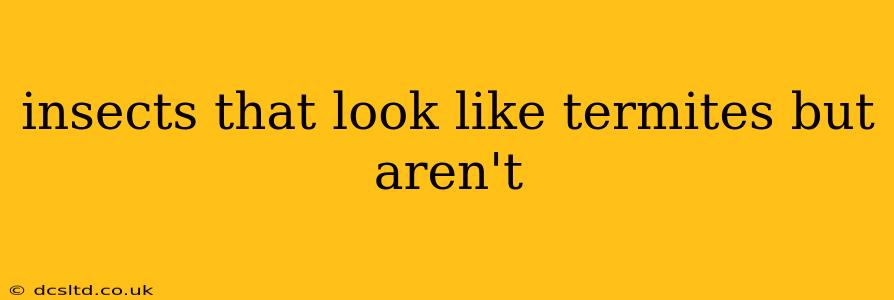Termites are notorious for the damage they inflict on homes and structures. However, several other insects can easily be mistaken for termites, leading to unnecessary worry or, conversely, a delay in addressing a genuine termite infestation. This comprehensive guide will help you differentiate between true termites and their look-alikes. We'll explore their physical characteristics, behaviors, and habitats to equip you with the knowledge to accurately identify these pests.
What are the key physical characteristics of termites?
Before we delve into the imposters, let's establish a baseline understanding of what termites look like. Termites are generally small, pale-colored insects, often described as creamy white or light brown. They have a straight body (unlike ants, which have a distinct waist), and their antennae are straight and beaded. Soldier termites, identifiable by their large heads and powerful mandibles, are particularly distinct. Workers, on the other hand, are smaller and less noticeable. These variations in appearance within a termite colony are crucial to understand when attempting identification.
What insects are often mistaken for termites?
Several insects share similarities with termites, causing confusion. The most common culprits include:
Ants:
This is perhaps the most frequent case of mistaken identity. Certain ant species, especially carpenter ants, can resemble termites, particularly the workers. However, closer inspection reveals key differences: ants have a constricted waist (a narrow segment between the thorax and abdomen), while termites have a straight body. Ants also have bent antennae, unlike the straight antennae of termites. Furthermore, carpenter ants are generally darker in color than termites.
Booklice:
These tiny insects are often found in damp, humid environments, similar to termites. They are much smaller than termites, however, and have a more elongated, slender body shape. Their movements are also quite different; booklice move much more slowly and less aggressively than termites.
Cockroach Nymphs:
Young cockroaches, or nymphs, can sometimes be mistaken for termites due to their pale color and size. However, cockroaches have long, slender antennae, unlike the beaded antennae of termites. Their legs are also noticeably longer and more spiny. Adult cockroaches, of course, are much larger and easily distinguishable.
Ground Beetles:
Certain species of ground beetles, especially their larvae, can mimic the appearance of termites. However, ground beetles often exhibit distinct markings or patterns on their bodies which termites typically lack. Their size and the environment in which they're found can also provide differentiating clues.
How can I tell the difference between termites and look-alikes?
The best way to distinguish between termites and their look-alikes is through careful observation. Consider these factors:
- Body Shape: Observe the presence or absence of a constricted waist.
- Antennae Shape: Are the antennae straight or bent? Beaded or not?
- Color: Note the overall color of the insect.
- Size: Compare the size of the insect to known termite sizes.
- Behavior: Observe the insect's movement and activity.
- Habitat: Where was the insect found? Damp, dark areas are more indicative of termites or other similar pests.
What should I do if I suspect a termite infestation?
If you suspect a termite infestation, it's crucial to consult a professional pest control expert. A qualified technician can accurately identify the insects, assess the extent of the infestation, and recommend the appropriate treatment. Do not attempt to treat a termite infestation yourself, as this can often worsen the problem.
Are there any specific behaviors that distinguish termites from other insects?
Termites exhibit distinct behaviors, primarily swarming, which is a crucial sign of an active colony. This swarming involves winged reproductive termites emerging from the colony to mate and establish new nests. While some ants also swarm, the appearance of the swarmers (their body shape, antennae, and color) will help you differentiate them. Additionally, termites are generally more active in concealed areas within wood or structures, whereas other insects might be more visible on surfaces.
How can I prevent termite infestations in my home?
Prevention is key to avoiding costly termite damage. Maintain proper ventilation in your home to reduce moisture levels. Ensure soil doesn't contact the wooden framework of your house, and regularly inspect wood for signs of damage or infestation. Consider professional termite treatments as a preventive measure.
By carefully considering these factors and utilizing the information presented here, you can improve your ability to distinguish between termites and insects that merely resemble them. Remember, if you have any doubt, seeking professional help is always the best course of action.
